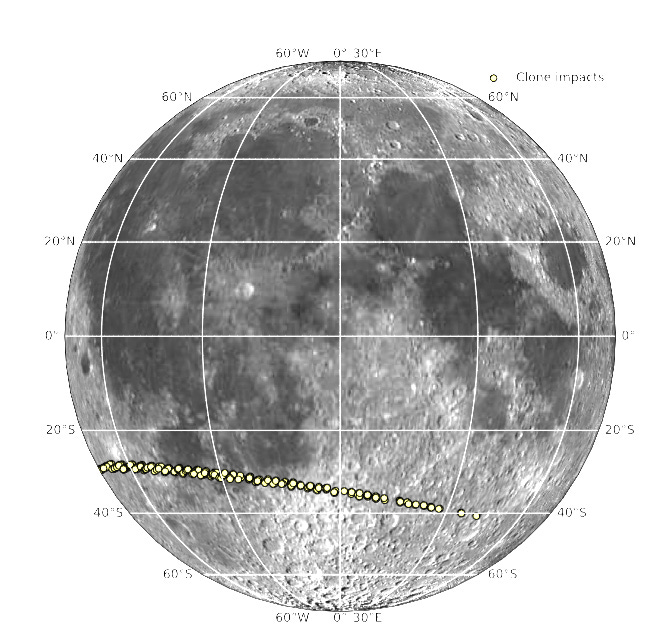Moon-bound asteroid could cripple Earth's satellites, say astronomers
An asteroid strike in 2032 could create an intense shower of debris that would devastate satellite constellations and human space operations
ATLAS, the Asteroid Terrestrial-impact Last Alert System, is NASA’s eyes-on-the-sky facility that searches for rocks heading our way. In December last year, it created a brief flurry of interest after discovering a 60-meter asteroid called 2024 YR4 that had a small chance of hitting Earth.
Further observations by the James Webb Space Telescope soon ruled out the possibility of a collision. But in April, NASA announced that 2024 YR4 had a 4 per cent chance of hitting the Moon instead. The date of impact, should it come to pass, is 22 December 2032, just seven years from now.
That raises an important question: what kind of threat would such an impact pose to Earth, particularly from the huge cloud of rock and dust ejected into space?
Now we have an answer thanks to the work of Paul Wiegert at The University of Western Ontario in Canada and colleagues who have calculated consequences. They say the impact is likely to send a high-velocity storm of lunar rock towards Earth’s satellite infrastructure, with the potential to cripple systems that underpin many aspects of modern life.
“The instantaneous meteoroid flux could – if the asteroid impacts the Moon in a favourable spot — reach 10 to 1000 times the background meteoroid flux at sizes which pose a hazard to astronauts and spacecraft,” say Wiegert and co.
Pyramid power
2024 YR4 is 60 metres across, about the size of the Great Pyramid of Giza. An impact with the moon would excavate a crater roughly a kilometre in diameter and blast as much as 100 million kilograms of lunar rock and dust into space, much of it at speeds exceeding the Moon's escape velocity.
That’s about the mass of a Nimitz-class aircraft carrier but pulverised into particles between 0.1 and 10 millimetres in size.
This storm cloud could inflict considerable damage. But much depends on where on the moon the asteroid might hit. To work out the possible sites, the researchers simulated ten thousand possible trajectories for the asteroid, which showed it most likely to hit a corridor across the Moon's southern hemisphere.
The team then modelled the ejection of debris from various points along this path. It turns out that an impact on the Moon’s trailing side is much more likely to send debris towards Earth than impacts elsewhere.
This brief but intense shower of lunar debris would dramatically increase the risk to satellites, which are subjected to a light background flux of micrometeroids. “Our predicted flux represents an equivalent exposure of up to 10 years over just a few days,” say Wiegert and co.
The combined probability of the asteroid hitting the Moon in this most dangerous trailing side area is about 1 per cent. But that’s a number that concerns Wiegert and co. "The 1:100 odds of this scenario exceed the usual threshold of concern for asteroid Earth impact warning systems," they say.
Beyond Earth
But ATLAS, and the analyses of its data, are designed to look for asteroids that threaten Earth directly.
So the team argues that it is time to rethink the scope of planetary defence. "Our analysis highlights that issues of planetary defence extend beyond just the effects of impacts on Earth's surface."
Building a more accurate picture of the rock’s likely trajectory is now crucial. Asteroid 2024 YR 4 will be visible again in 2028 when its trajectory can be refined.
In the meantime, astronomers, satellite operators and the customers they serve will be nervously brainstorming the nightmarish possibilities that could occur should the impact come to pass. And worrying that too little time remains to prepare.
Ref: arxiv.org/abs/2506.11217 : The Potential Danger to Satellites due to Ejecta from a 2032 Lunar Impact by Asteroid 2024 YR4
INSIGHT
This research fundamentally reframes planetary defence, extending it beyond Earth's surface to include the burgeoning infrastructure in orbit. The key insight is that even a non-terrestrial impact, specifically on the Moon, can pose a significant threat to vital satellite constellations. However, this threat has never been considered.
Various studies have contemplated the loss of satellite systems like GPS, which offers timing information as well as location data. Such a loss would immediately impact transport services such as air traffic control, communication networks and the finance industry which uses GPS systems to timestamp transactions. The likely result would be global chaos.
That makes it an urgent priority to incorporate the effect of lunar impacts into risk assessments for space assets. Satellite operators and space agencies must develop mitigation strategies for such an event. This could involve temporarily reorienting spacecraft and satellites to shield vulnerable components or even minor orbital adjustments.
But the most important risk is to human operations. By 2032, NASA expects the International Space Station to have been decommissioned and replaced with a commercially operated alternative.
The Artemis moon program will also be well underway. Although the timing is not confirmed, the program includes a lunar base with its own nuclear reactor, a space station orbiting the moon and a permanent human presence. All this will be at risk from 2024 YR4.
Several actions are now urgently needed beyond studying 2024 YR4 in more detail. For example, physicists will need to better constrain the ejecta physics, particularly the size-frequency distribution of smaller, hazardous particles.
Policy discussions will also be needed to formally expand the definition of planetary defence to encompass economic and scientific assets beyond Earth's atmosphere, including potential sites on the Moon.



